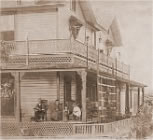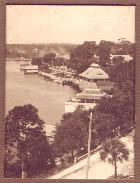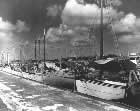 |
|||||||||||||||||||
 |
 |
||||||||||||||||||
 |
 |
||||||||||||||||||
|
History
|
|||||||||
| Historical photos of Tarpon Springs | |||||||||
|
|
|||||||||
| PHOTOS NEEDED - The 50's and 60's were 50 years ago and the Archives are seriously lacking in photos of Tarpon Springs during that time period. If you have pictures of that era help us out. Thank you. | |||||||||
|
|
|||||||||
|
The City of Tarpon Springs is located on the Anclote River less than a mile from the Gulf of Mexico. Its name was inspired by a fish, the tarpon, which was abundant in the waters around the city during the late nineteenth century. Although the details of the naming are uncertain, several accounts attribute it to early settlers who arrived in the 1870s.
|
|||||||||
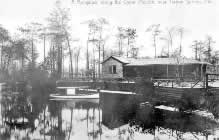 The first private landholder in the area was Samuel E. Hope, who purchased land on the north side of the river in 1864. In that same year, William and Julia Thompson, originally from South Carolina, homesteaded land that is now on the corner of Nebraska and US 19. They moved down from Bronson, Florida. The house now has an historic designation and is called the Thompson-Jukes house. Three years later two brothers from Ocala, Frederic and Ben Meyers, purchased land from Hope. In 1876 A. W. Ormond and his daughter, Mary, moved from South Carolina and became the first settlers to live in what are now the city limits of Tarpon Springs. The first private landholder in the area was Samuel E. Hope, who purchased land on the north side of the river in 1864. In that same year, William and Julia Thompson, originally from South Carolina, homesteaded land that is now on the corner of Nebraska and US 19. They moved down from Bronson, Florida. The house now has an historic designation and is called the Thompson-Jukes house. Three years later two brothers from Ocala, Frederic and Ben Meyers, purchased land from Hope. In 1876 A. W. Ormond and his daughter, Mary, moved from South Carolina and became the first settlers to live in what are now the city limits of Tarpon Springs. |
|||||||||
|
Bungalow on Anclote River
|
|
||||||||
|
The event that hastened the development of Tarpon Springs, as well as the settlement of much of the
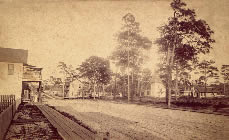 southern half of Florida, was the Disston land purchase of 1881. Hamilton Disston, a wealthy saw manufacturer from Philadelphia, shrewdly acquired 4,000,000 acres of state land at $.25 per acre from the Florida Internal Improvement Fund. This fund had been set up in 1855 to administer state lands that were available for sale to the public. After the Civil War, the fund became mired in debt and by state statute could not sell land until the debt was cleared. Approximately 20,000 acres of the purchase were located in what are now Pinellas, Pasco, and Hillsborough counties. southern half of Florida, was the Disston land purchase of 1881. Hamilton Disston, a wealthy saw manufacturer from Philadelphia, shrewdly acquired 4,000,000 acres of state land at $.25 per acre from the Florida Internal Improvement Fund. This fund had been set up in 1855 to administer state lands that were available for sale to the public. After the Civil War, the fund became mired in debt and by state statute could not sell land until the debt was cleared. Approximately 20,000 acres of the purchase were located in what are now Pinellas, Pasco, and Hillsborough counties..................................................................................................................................... |
|||||||||
|
In 1882, Disston's surveyor, Major Mathew Robinson Marks, conducted the first survey and laid out the town of Tarpon Springs. Disston formed the Lake Butler Villa Company (at that time Lark Tarpon was called Lake Butler) and selected Tarpon Springs as the base of operations because of its location.
|
|||||||||
|
Disston chose Anson P. K. Safford, a business acquaintance of long standing, to head his activities here. Safford was born in Vermont and grew up in Illinois. At age 20 he moved west with the Gold Rush and was elected to the California assembly six years later. He was appointed to be surveyor general of Nevada and in 1869 was appointed territorial governor of Arizona. One of his major accomplishments was the establishment of the Arizona public school system. His involvement in Arizona mining ventures made him a wealthy man, and he moved to Philadelphia, where he renewed his acquaintance with Disston.
|
|||||||||
|
Safford House
|
|
||||||||
|
Gradually the town grew. In 1884 a post office was opened with Ed Blum, a Russian Jew, serving as the postmaster. Within a few years, the town had attracted about 300 residents and decided to incorporate. On February 12, 1887 Tarpon Springs became the first incorporated city on the Pinellas peninsula. |
|||||||||
T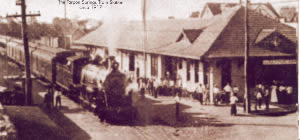 he second major event of 1887 was the arrival of the first railroad, the Orange Belt Railway. Three years earlier, Granville Noblit, a surveyor for Orange Belt, surveyed land from Tarpon Springs to St. Petersburg for a railway. The city of Tarpon Springs granted the railroad land and built a depot. The right-of-way for the line was donated by Disston. Before the trains came to Tarpon, the city could be reached only by boat or a circuitous train and steamboat route or overland by oxcart, wagon, or horseback from Tampa. Transportation advances in 1887 also included the construction of the lighthouse on Anclote Key. he second major event of 1887 was the arrival of the first railroad, the Orange Belt Railway. Three years earlier, Granville Noblit, a surveyor for Orange Belt, surveyed land from Tarpon Springs to St. Petersburg for a railway. The city of Tarpon Springs granted the railroad land and built a depot. The right-of-way for the line was donated by Disston. Before the trains came to Tarpon, the city could be reached only by boat or a circuitous train and steamboat route or overland by oxcart, wagon, or horseback from Tampa. Transportation advances in 1887 also included the construction of the lighthouse on Anclote Key. |
|||||||||
| Tarpon Springs enjoyed the benefits that much of Florida realized in the late 19th century when the state became a popular winter resort for wealthy Americans from various parts of the country. Some of the imposing homes that remain in the city today were built during this period. | |||||||||
| Growth and progress did not come without setbacks. In December 1891 the city lost two of its leading citizens when Anson and Dr. Mary Jane Safford died within a week of each other. During the winter of 1894-1895, two periods of record low temperatures severely damaged the citrus crop, a major source of income for the area. Then in 1894 much of the city's central business core was destroyed by fire. When merchants rebuilt, they replaced their stores and offices with structures made of brick and stone, with tin ceilings and metal roofs that would be less flammable than the original wooden ones. | |||||||||
| The founding of the commercial sponge industry in 1890 changed Tarpon Springs forever. Newly arrive American settlers had discovered sponges in the Florida Keys during the 1820s. About 1849, spongers in the Keys organized a commercial sponging operation, using long poles with grapples to harvest the sponges. | |||||||||
.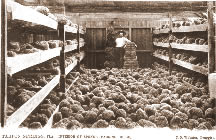 The west coast sponge beds were discovered accidentally in 1873 by Key West turtle fishermen whose nets were fouled by sponges off the mouth of the Anclote River. Spongers came to the area to work the beds, and some moved to Tarpon Springs. In 1890 John Cheyney, a Tarpon businessman, opened the Anclote River and Rock Island Sponge Company across the river from Tarpon. During the 1890s, sponge packing houses were built in the city, sponge presses were installed, and buyers moved to town. Gradually the sponge business shifted from Key West, Cuba, and the Bahamas to Tarpon, and by 1900 the city was considered the largest sponge port in the United States. |
|||||||||
It was, however, the Greek immigrants who expanded and refined sponging in 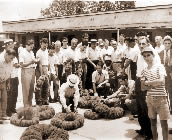 Tarpon Springs. The individual who is responsible for the Greek involvement is John Corcoris, who arrived in Tarpon in 1896 as a sponge buyer for a New York firm. He went to work for John Cheyney, who financed Corcoris' early efforts to make the industry more efficient. In 1905 Corcoris introduced the first mechanized sponge fishing boat to Tarpon Springs and brought in 500 Greek divers from Kalymnos, Halki, Symi, Hydra, Spetse, Aegena and other islands. Other Greeks soon followed and businesses were established to serve the Greek community, including restaurants, candy shops, coffee houses, and grocery stores. Sponge merchants and brokers then came to Tarpon, and their presence helped to create a well-integrated industry. They built boats, loaned money to boat owners, and supplied tools and equipment to the entire sponge fleet. In 1906 the Sponge Exchange Bank was established, and in 1908 the Sponge Exchange was founded. Profits from sponging also financed other businesses, such as the Sponge Exchange Cigar Company. |
|||||||||
| Spring Boulevard c1920s | |||||||||
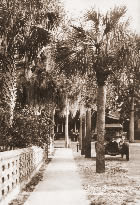 The city acquired a new look in the decade before WWI. The city acquired a new look in the decade before WWI. 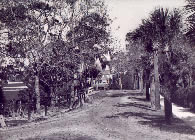 ........Spring Boulevard - c 1920s ........Spring Boulevard - c 1920sThe Tarpon Springs High School was built in 1912, the waterworks was constructed in 1914, and the impressive new City Hall opened its doors in 1915. By 1910 Tarpon Springs included an ice plant, an electric plant, two lumber mills, cigar factories, several banks and a post office. Tarpon Springs experienced the real estate boom and increase in tourism that characterized Florida during the 1920s. Many new subdivisions were laid out, tripling the area of the original town, and a number of impressive buildings were constructed, including the Sunset Hills Country Club, Arcade Hotel, Villa Plumosa, a new high school, an amusement pier, a water plant,
|
|||||||||
| ........ |
Spring Bayou........
|
||||||||
|
Tourism has replaced sponging as Tarpon Springs major economic activity. Thousands of visitors come to the city each year to enjoy the outdoors, playing golf or fishing, visiting the Sponge Docks, experiencing Greek culture, shopping for art and antiques, and touring charming Victorian neighborhoods.
|
|||||||||
|
|
Contact us at |
|
|
|
